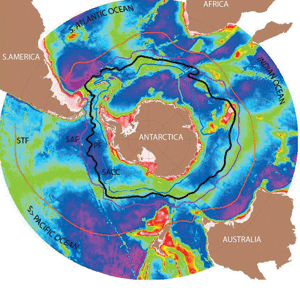
|
Published:
Ozone layer, wind shift may create ‘moment of grace’
The most influential current driving the world’s climate has long been thought to be the so-called global ocean conveyor belt that powers the Gulf Stream. But a US scientist now argues that the Antarctic Circumpolar Current (ACC) is far more important.
Joellen Russell, Assistant Professor of Geosciences at the University of Arizona, says a newly revealed connection between westerly winds, the ACC and the ozone layer is lessening the effect of global warming – but there is a catch.1
The ACC is the largest ocean current on the globe. Visible from space and four times more powerful than the Gulf Stream, this wind-driven current circles Antarctica, separating the warmer waters of the subtropics from the polar waters around the continent, and reaching all the way from the surface to the ocean floor – five kilometres below. In places the ACC is so strong that it scours the ocean floor.
Westerly winds push water away from Antarctica, giving rise to an upwelling from two to three kilometres down – in effect, creating a window connecting the deep ocean and the surface. The Southern Ocean is the only place on the globe where water upwells from this depth.
When it surfaces, the water from below provides a sink for atmospheric CO2 (while also releasing some CO2 from the depths). Professor Russell says the net effect helps the Southern Ocean to ‘punch well above its weight’ in the uptake of carbon. ‘It covers less than 25 per cent of the surface area of ocean but has absorbed 40 per cent of the anthropogenic carbon in the world’s oceans.’
In the last 40 years, the westerly winds have strengthened and shifted southwards – like a giant shrinking donut – from latitude 47–48°S to 53°S, exacerbating the drought in southern Australia.
Two key factors are causing this southerly wind shift – global warming and the hole in the ozone layer. Increasing CO2 concentrations act as a thermal blanket, trapping heat in the lower atmosphere and causing a 0.8°C increase, while, at the same time, cooling the upper atmosphere (the stratosphere).

|
|
Many of Antarctica’s large penguin colonies may disappear by mid-century if ice shelves melt too quickly. Credit: ScienceImage
|
The depletion of ozone is also cooling the stratosphere over Antarctica, where the temperature has fallen by 7°C. The combination of ozone reduction and the increased concentration of CO2 has increased the temperature gradient between the upper and lower atmosphere, which in turn has strengthened the westerly winds.
These stronger westerlies have increased the amount of upwelling around Antarctica, enabling the Southern Ocean to absorb additional CO2 and heat, which has helped slow the rate of global warming.
But this sink effect won’t last forever. As the world warms, the layer of warm water on the surface of the ocean will deepen, causing a stratification effect to override the upwelling influence of the westerlies.
Ten years ago it was thought stratification would occur by 2030, closing the ‘window’ connecting the deep ocean and the surface.
However, Professor Russell and her colleagues expect the sink effect to continue for another century. She believes the hole in the ozone layer has helped create ‘a moment of grace’, as the stronger westerly winds are keeping the ‘window’ open.
Slowing global warming in this way has an ecological downside – the absorption of additional heat and CO2 is warming the ocean and increasing ocean acidification. The resultant melting of sea ice and ice shelves has grave implications for ice-dependent species: it is forecast that by 2037 three-quarters of Antarctica’s large penguin colonies will be gone.2
1 Toggweiler, JR & J Russell (2008) Ocean circulation in a warming climate. Nature, 451, 286–88.
2 Ainley D, JL Russell, S Jenouvrier, E Woehler, P O’B Lyver, WR Fraser & GL Kooyman. Antarctic penguin response to habitat changes as Earth’s troposphere reaches 2°C above pre-industrial levels. Ecological Monographs, in press.




